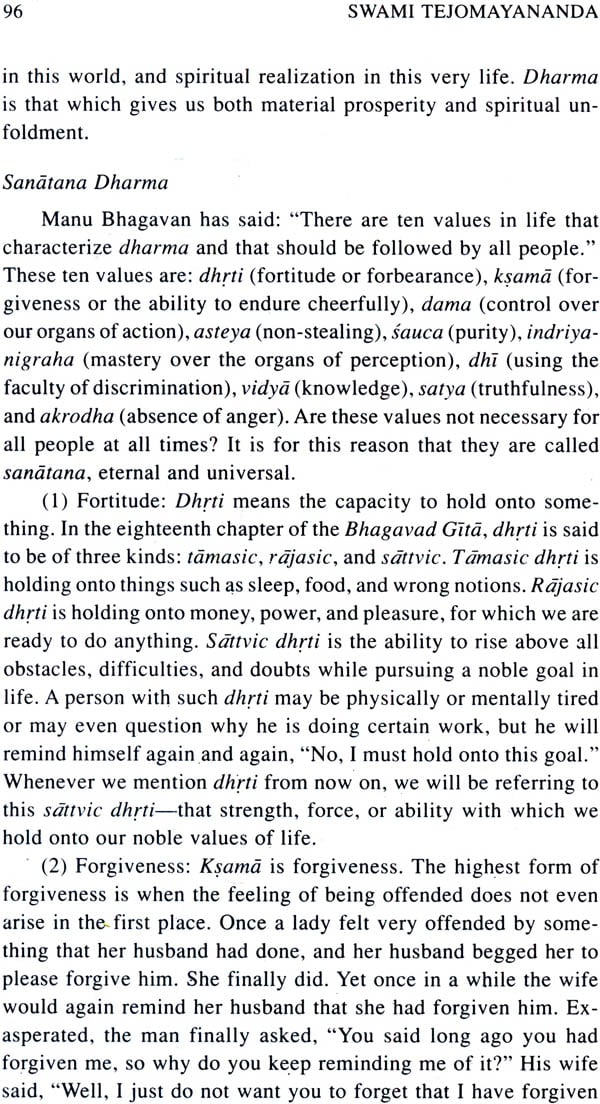
Hindu Culture – An Introduction
Book Specification
| Item Code: | NAC672 |
| Author: | Swami Tejomayananda |
| Publisher: | Central Chinmaya Mission Trust |
| Language: | English |
| Edition: | 2009 |
| ISBN: | 9788175971653 |
| Pages: | 181 (Illustrated In B/W) |
| Cover: | Paperback |
| Other Details | 8.5 Inch X 5.5 Inch |
| Weight | 200 gm |
Book Description
Swami Tejomayananda, disciple of renowned Vedanta master Swami Chinmayananda, demystifies many aspects of Hindu culture by unlocking the secrets of its symbology. In introducing the deeper meaning of Hinduism’s many gods, he says, “All the different forms of Hindu gods and goddesses are but one God expressing in different ways.”
Defining the Vedas as the source of Hindu culture, Swami Tejomayananda explains their relevance to today’s social and individual problems, using simple analogies that speak to the heart and mind of the modern reader. With deep insight and sensitivity, he analyzes topics such as:
• The symbology of idols
• The cultural role of the temple
• The symbolic meaning of Hindu deities
• Hindu festivals
• Vegetarianism
• The four castes
• The Mahabharata
• The Puranas
The Hindu culture is founded upon the sacred scriptures of the Vedas, which provided the enduring foundations upon which this most ancient of civilizations was built. These sacred scriptures are revered even today, for they contain revelations of eternal Truth and embody the spiritual and cultural heritage of the Hindu people.
The term “Hindu” was coined by the Persians to designate a group of people living east of the river Sindhu or Indus. These people referred lo their religion as sanatana dharma (eternal dharma)—eternal—because the principles it proclaimed were of a universal nature. Their thinkers (the rishis), being subjective scientists, had experienced and touched a deep cord within, far beyond the physical, mental, and intellectual layers, which allowed them to see all life as interconnected. They saw the One manifested throughout the universe so that everything was sacred to them. When life itself is honored and belief in the holiness of all life is fostered, one cannot help but acquire a deep sense of reverence for life. The Hindu culture evolved out of this expanded vision.
Civilization flourishes with the promotion of culture, but when the cultural values deteriorate, civilization declines. This can be seen, for instance, with the fall of the Greek and Roman empires. When higher ideals are no longer pursued and fundamental principles of civilization are ignored, the result will be great moral confusion. This is the unfortunate condition of the world today.
The great religious masters of India have time and again revived their glorious culture. In no other philosophical system in the world have these values been so beautifully and exhaustively dealt with as in the sacred books of India. These cherished books offer nourishing inspiration and guidance. The great spiritual authors speak to us of visions and values that reflect their realization of the One in the many.
Hindu Culture evolved out of a series of lectures given by Swami Tejomayananda in Los Altos in 1991. The lectures were originally designed to instruct those individuals who were teaching children and youth. Thus Swamiji brings out all the vital aspects and dynamism of this culture. That we can still hear the echo of his words reverberating in our hearts long after we have heard or read them, shows the incredible power of his communication skills. By explaining the value of a value, he motivates us to incorporate time-honored principles into our lives. When we realize that our actions influence the entire society, the value system that we live by and the choices that we make become of paramount importance.
In Part One, Swami Tejomayananda examines the two basic types of culture, material and spiritual, and emphasizes the need for culture. He then shows how the various texts of the Hindu cultural tradition all use different ways and means to inculcate value systems.
Part Two explores the art of symbolism. God-symbolism has a language of its own, and we need the help of a Vedantic master to grasp this subtle science. Understanding the deep inner meaning represented by the symbols is to discover at the same time profound philosophical truths.
Swami Tejomayananda explains the full significance of sanatana dharma in Part Three. He points out that adherence to values lends a sense of dignity, direction, and purpose to every individual.
In Part Four we are encouraged to enrich our lives by studying the immortal epics, the Ramayana and the Mahabharata. We see the entire gamut of human emotions displayed throughout these epics, and marvel at the beauty of a culture that can impart ethical and spiritual training in such a natural way.
A culture based on a dynamic and practical philosophy which indicates the goal of life and the many ways to reach it cannot help but have an enduring quality about it. These fundamental ideas have provided a spiritual base and direction to the Hindu culture throughout the age. Scriptures assure us that there will be true guides of the spirit in every age leading humankind to its ultimate fulfillment. Swami Tejomayananda is such a guide. By giving an overview of this great culture he helps us reassess our value systems and motivates us to live these universal principles.
| Preface | i | |
| Part One – Introduction to he Vedas | ||
| I. The Definition of Culture | 8 | |
| II. The Basis of Culture | 16 | |
| III. The Vedas and Culture | 20 | |
| IV. The Karma Kanda | 30 | |
| V. The Jnana Kanda | 41 | |
| Part Two – The Language of Symbolism | ||
| VI. The Need for Symbols | 56 | |
| VII. Installation of the Religious Idol | 66 | |
| VIII. Symbolism of Lord Shiva | 72 | |
| IX. The Sastras | 81 | |
| Part Three – The Essence of Dharma | ||
| X. Indicators of Dharma | 92 | |
| XI. Vegetarianism | 100 | |
| XII. The Four Stages of Life | 104 | |
| XIII. The Four Castes | 112 | |
| XIV. The Purpose of Religious Festivals | 119 | |
| Part Four – The Epics | ||
| XV. Itahasa and Puranas | 130 | |
| XVI. The Mahabharata | 138 | |
| XVII. The Characters of the Mahabharata | 147 | |
| XVIII. The Puranas | 157 |







